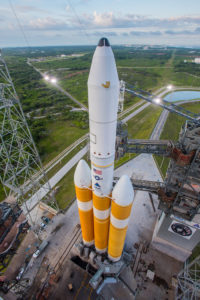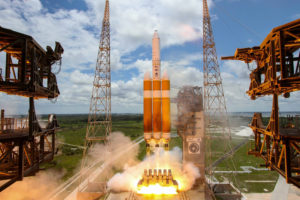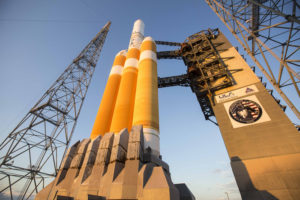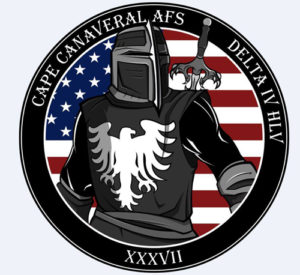Ah, the Delta IV Heavy. The most powerful active launch vehicle in the world. While other launch vehicles have surpassed its capacity, few of those actually had successful flights, and regardless of their successes, or lack thereof, none of these top tier boosters are in production anymore.
In December 2014, a Delta IV Heavy booster lifted, in what may go down as its most historic payload, a test version of the Orion capsule, our future crewed space exploration vehicle. While Orion is destined to make its future history making flights on a dedicated booster system known as SLS (Space Launch System), the Delta IV Heavy had its next launch since Orion today, June 11th, 2016.

A beautiful shot of the Delta IV Heavy for NROL-37. In the upper left, you can see the remains of the old Saturn 1B launch complex, LC-34.
This launch was the kind of payload it was intended to carry: a National Reconnaissance Office satellite used for military reconnaissance operations. While, obviously, information about this payload is classified, we can determine that it is clearly a very heavy satellite from the simple need for such a powerful booster. Rumors suggest this payload is another “Orion” class satellite, which is used for radio signal interception style reconnaissance. It is said that these satellites, due to their antenna designs, are effectively the largest satellites ever launched, and considering the Delta IV Heavy, it would make sense for them to be such.

The launch of NROL-37. Note the scorched foam insulation on the tankage, and the orange glow in the flame, caused by carbon burning from the nozzles of the engines.
This launch was originally scheduled for June 9th, but weather prevented the safe launch of the booster. I sat waiting for hours, just to hear the moment the 4 minute hold ended another hold call being made, as expected, due to weather. Rocket launches are funny like that – we almost lost Apollo 12 due to a lightning strike during its launch in late 1969 (perhaps I should write about that sometime soon). Naturally, for the sheer cost and critical nature of most any payload, you wouldn’t want to launch under a condition where the vehicle could be lost due to something as uncontrollable as lightning, right?
Today’s countdown and launch went without any issue, though, and until the news blackout 6 and a half minutes into the launch, the flight appeared to go without any problems – a “nominal” launch, as terminology is. The Delta IV Heavy did it’s job, and did it well, as it has for all but one of its missions – there was one partial failure, but the payload was still in a usable orbit.
The Delta IV Heavy has become one of my favorite launch vehicles, and maybe I’ll write about it, in a dedicated fashion, in the near future. For now, enjoy this launch video of NROL-37 on a Delta IV Heavy.
https://en.wikipedia.org/wiki/Orion_(satellite)
https://en.wikipedia.org/wiki/Delta_IV_Heavy


